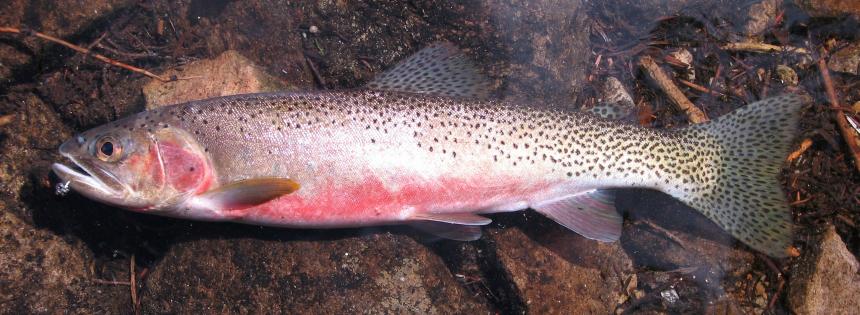Low-
Moderate
Description and Range
Physical description
The westslope cutthroat trout is another trout that is a popular game fish and it is one of three subspecies of cutthroat trout that occur in Washington. It is also one of two cutthroat trout subspecies that are native to Washington. The other two are coastal (native) and Lahontan (non-native). Westslope cutthroat trout have an olive/bronze colored back and greenish-gold colored sides. Some red coloration can be seen on the gill cover and body. As with all cutthroat trout, they have the distinctive red slash mark on each side of their lower jaw and teeth on the back of their tongue. Westslope spots are primarily above the lateral line and are few there, but quite numerous on the posterior region of the body as well as the on the dorsal, adipose, and caudal fins. The westslope cutthroat trout got its name from being first described west of the Continental Divide. The do however occur both east and west of the Continental Divide.Average 8-12 inches. Westslope cutthroat can grow up to 16+ inches in quality populations.
Climate vulnerability
Sensitivity to climate change
Low-
Moderate
Cutthroat trout spawn in the spring and are thus sensitive to the timing and magnitude of snowmelt and the accompanying flood pulse. Winter floods do not pose a risk to cutthroat embryos, but it is possible that increased severity of fall and winter floods could negatively affect overwintering juveniles (although quality data on this topic are lacking due to the challenge of monitoring survival in flood prone systems). Like many stream rearing salmonids, cutthroat can be vulnerable to sub-optimally warm temperatures during base flow periods in late summer and fall. During these low flow periods, terrestrial subsidies typically comprise the dominant food source for trout, and may be critical for enabling fish to offset the elevated metabolic costs caused by higher water temperatures. Factors that mediate the magnitude of terrestrial subsidies, such as land use practices in riparian areas, can in turn mediate the sensitivity of trout to altered thermal regimes. Recruitment of cutthroat trout in high elevation streams may be constrained by cold, rather than warm, summer temperatures. Warming may have some positive effects by increasing the amount of high-elevation habitat capable of rearing juvenile cutthroat. The primary source of decline for westslope cutthroat has been hybridization with rainbow trout. A key uncertainty is how climate conditions might facilitate hybridization. Genetically pure cutthroat often exist in cold tributary streams and cutthroat show subtle signs of being better adapted to cold temperatures than rainbow trout when studied in the laboratory. This suggests warming temperatures could increase hybridization by allowing rainbow trout to invade cold headwater streams. However, in an analysis across a large watershed, environmental factors were not as important as demographic factors in determining levels of hybridization. Westslope cutthroat are unique among the cutthroat subspecies in that they exhibit an anadromous, coastal-roaming ecotype. Populations with this life-history present may be less sensitive to altered flow and thermal regimes in freshwater because there is less cumulative exposure to freshwater conditions and individuals at sea can survive ephemeral climate-related disturbance such as thermal stress events or periods of low flow. Westslope cutthroat trout exihibit adfluvial (live in lakes and spawn in tributaries), fluvial (live in rivers and spawn in tributaries) and resident life-history forms, and their use of lakes and larger rivers may provide them with some resilience to higher temperatures and decreasing flows that may occur in smaller tributaries in summer months
Exposure to climate change
Moderate
- Increased spring flood events
- Altered runoff timing and amount
- Increased water temperatures
- Lower summer flows
Where you may encounter westslope cutthroat trout
Lakes where this species may be found
How to fish for westslope cutthroat trout
Fishing prospects calendar
Westslope cutthroat trout are aggressive and opportunistic feeders, primarily preying on insects and other invertebrates. This translates into them being a cooperative quarry for anglers. They love natural baits, with the best bait being nightcrawlers or a large garden worm. Small wobbling spoons and spinners are also effective. Fly anglers can be successful using streamers and nymphs as well as dry flies.
In the spring and fall, when the water tends to be cooler, westslope cutthroat will be found near the surface, but they are wary and spook easily. Spin-fishing with a small wet fly or midge and a spinning bubble works best. As summer approaches and the water begins to warm, westslope cutts will seek deeper areas off points and drop-offs. Try trolling with spoons or bait on a leader attached to cowbells or Davis-rigs. During the summer months, shore anglers are successful using worms, cheese, and marshmallows.
Remember, when handling any fish you intend to release, wet your hands first so you don't take off the fish's protective slippery coating. Dry hands will remove the protective coating and make the fish vulnerable to bacterial or fungal infections, which can kill them.
State record
- Weight
- 4.71 lbs
- Angler
- Angus Kerr
- Location
- Abernathy Lake, Okanogan County
- Date Caught
- October 8, 2006
